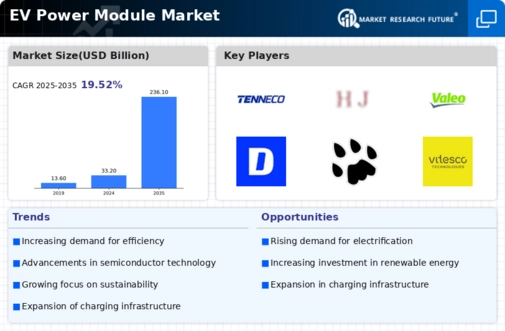Increased Focus on Sustainability
The growing emphasis on sustainability and environmental responsibility is a key driver of the EV Power Module Market. As consumers and corporations alike prioritize eco-friendly practices, the shift towards electric vehicles becomes more pronounced. In 2025, it is estimated that the market for sustainable transportation solutions will reach unprecedented levels, with a significant portion attributed to electric vehicles. This trend compels manufacturers to innovate and produce power modules that not only enhance vehicle performance but also align with sustainability goals. As a result, the EV Power Module Market is likely to witness a surge in demand for environmentally friendly power solutions, reflecting the broader societal shift towards sustainability.
Government Incentives and Policies
Government initiatives aimed at promoting electric mobility play a crucial role in shaping the EV Power Module Market. Various countries have implemented policies that provide financial incentives for EV purchases, such as tax credits and rebates. These measures not only encourage consumers to transition to electric vehicles but also stimulate demand for high-performance power modules. For instance, in 2025, several nations are expected to allocate substantial budgets to support EV infrastructure development, including charging stations and power module advancements. This regulatory support fosters a conducive environment for the growth of the EV Power Module Market, as manufacturers align their strategies with government objectives.
Rising Demand for Electric Vehicles
The increasing consumer preference for electric vehicles (EVs) is a primary driver of the EV Power Module Market. As more individuals and businesses recognize the environmental benefits and cost savings associated with EVs, the demand for efficient power modules has surged. In 2025, the number of electric vehicles on the road is projected to exceed 30 million units, indicating a robust growth trajectory. This surge necessitates advanced power modules that can enhance vehicle performance and efficiency. Consequently, manufacturers are focusing on developing innovative power modules that cater to the evolving needs of the automotive sector, thereby propelling the EV Power Module Market forward.
Expansion of Charging Infrastructure
The expansion of charging infrastructure is a pivotal factor driving the EV Power Module Market. As the number of electric vehicles continues to rise, the need for a robust and accessible charging network becomes increasingly critical. Investments in charging stations, particularly fast-charging options, are expected to increase significantly in 2025. This expansion not only alleviates range anxiety among consumers but also creates a higher demand for efficient power modules that can support rapid charging capabilities. Consequently, the growth of charging infrastructure is likely to stimulate advancements in power module technology, further propelling the EV Power Module Market.
Technological Innovations in Power Electronics
Technological advancements in power electronics are significantly influencing the EV Power Module Market. Innovations such as silicon carbide (SiC) and gallium nitride (GaN) technologies are enhancing the efficiency and performance of power modules. These materials allow for higher voltage and temperature tolerances, which are essential for modern electric vehicles. In 2025, the market for SiC and GaN-based power modules is anticipated to grow substantially, driven by their ability to improve energy efficiency and reduce overall system costs. As manufacturers adopt these cutting-edge technologies, the EV Power Module Market is likely to experience accelerated growth, catering to the increasing demands of the automotive sector.

















Leave a Comment